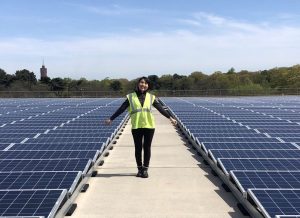By Pamela Berns
In 2020, the triple bottom line—people, planet, profits—took on a whole new meaning. The number of lives lost to COVID-19 continues to grow into the new year.
Environmental regulation rollbacks under the Trump administration and the US withdrawal from the Paris agreement put the planet on even greater climate risk trajectory than before. Job losses and business failures altered the economy in ways that economists say may take years to fix. According to
Fast Company, as of May, 2020, 33 million Americans had filed for unemployment; while some jobs might come back, new ones will need to be created to replace those that didn’t survive.
While, sadly, we will never recoup the lives lost and upended by the pandemic, there is a way forward toward a reciprocal recovery for all of the three Ps. “One of the best ways to add new jobs,” said Fast Company, is to “invest in green infrastructure.”
The Low Carbon Employment Future Already on its Way
A $1 million investment in energy efficiency creates around eight full-time jobs, nearly three times as many as an investment in fossil fuel,” said Fast Company. According to Devashree Saha, a senior associate at the nonprofit
World Resources Institute (WRI), jobs in the low-carbon sector have already been “growing at a much faster pace than overall employment, and they are expected to have dramatic growth going into the future.”
President-Elect Joe Biden agrees. “More than three million people in the United States are already employed in the clean energy economy. But, that is only the beginning of what is possible if we harness all of our talent and creativity. If executed strategically, our response to climate change can create more than 10 million well-paying jobs.”
GreenBiz sees increasing corporate commitment to sustainability, with an added focus on the circular economy. “Just as jobs in solar and wind power in the emerging renewable energy landscape outpaced work in the sputtering coal industry within a mere decade, so too will a circular workforce replace outmoded roles from high-carbon, high-waste economies.”
On the local level,
Circular NYC research “suggests the circular economy can create over 11,000 jobs in New York City by 2030. Alongside roles created by the transition to renewable energy, a New York circular economy could significantly boost the outcomes of the New York Works plan, which aims to create 100,000 good jobs.”
What are the Jobs and Where are They?
Joe Biden envisions “new industries and re-invigorated regional economies spurred by innovation from our national labs and universities; commercialized into new and better products that can be manufactured and built by American workers; and put together using feedstocks, materials, and parts supplied by small businesses, family farms, and job creators all across our country.”
A
2015 report by Circle Economy (PDF), an Amsterdam-based think tank puts circular jobs into three categories: “core” circular jobs, including those that involve regenerative resources, extend the life of products and rethink business models;
“enabling” circular jobs, including designing for the future; and “indirectly” circular jobs, in education, government and professional services, all support the more core circular functions.

According to the
Princeton Review Career Guide,“Whether you choose to couple a field like law or public policy with an interest in green issues, or approach the topic from your interest in biological or environmental science, students are entering green careers with many options to apply their passion and expertise.” Their list of actually placed job titles is long, and includes, to name only a few…
- Sustainability Coordinator
- Environmental Consultant
- Research Scientist
- Animal Rehabilitation Technician
- Residential Energy Efficiency Program Coordinator
- Director of Community Outreach
- Grant Writer
- Sustainability and Active Transportation Assistant
- Forestry Technician
- Field Biologist
- Retail Solar Advisor
- Wetland and Wildlife Scientist
- Manatee Biologist
Monster.com adds to that list, and offers guidelines on skills, education and experience needed, as well as typical salaries for such positions as energy auditor, environmental lawyer, hydrologist, landscape architect and more.
As we gradually put the challenges of 2020 behind us and get into the job of rebuilding, we can take a big dose of optimism along with us. That’s especially true for those of us who are committing our careers to healing our planet.
Want to prepare for a green career? Update your resume at our upcoming GreenHomeNYC Careers resume workshop on January 12.
Learn more about the Circular Economy at our upcoming Monthly Forum on January 27.
Also, check out our EventBrite link for additional resources on the Circular Economy.  According to the Princeton Review Career Guide,“Whether you choose to couple a field like law or public policy with an interest in green issues, or approach the topic from your interest in biological or environmental science, students are entering green careers with many options to apply their passion and expertise.” Their list of actually placed job titles is long, and includes, to name only a few…
According to the Princeton Review Career Guide,“Whether you choose to couple a field like law or public policy with an interest in green issues, or approach the topic from your interest in biological or environmental science, students are entering green careers with many options to apply their passion and expertise.” Their list of actually placed job titles is long, and includes, to name only a few…
